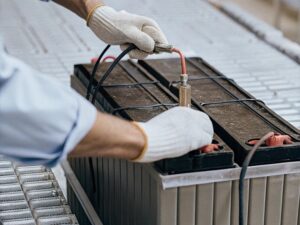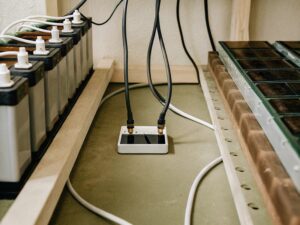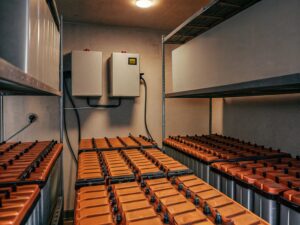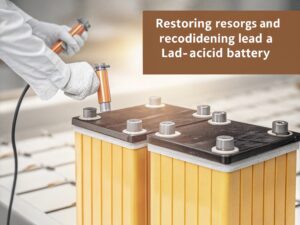How to Extending the Life of Your Lead Acid Batteries: Tips and Best Practices?
Premature battery failure can disrupt your power systems and drain your budget. Many users experience shortened battery lifespans due to improper maintenance, leading to unexpected downtime and replacement costs.
To extend lead acid battery life, maintain proper charge levels (keep between 20-80% charge), avoid temperature extremes, perform regular maintenance checks, use appropriate chargers, and prevent deep discharges. Timely recharging preserves the active materials in the battery.

In our years running BEVAULT battery factory, we've seen how proper maintenance can double or even triple battery lifespan1. Our customers who follow best practices consistently report getting years of additional service from their batteries. Let me share what works based on our manufacturing expertise and customer feedback.
How to Prolong Lead-Acid Battery Life?
Improper charging habits are killing your batteries prematurely. Many users unknowingly damage their batteries through incorrect charging patterns, resulting in reduced capacity and shortened lifespan.
To prolong lead-acid battery life, implement consistent charging routines, avoid leaving batteries in a discharged state, use temperature-compensated charging, prevent overcharging, and keep electrolyte levels proper in flooded types. Timely recharging prevents sulfation, the main cause of premature failure.

The science behind battery longevity is fascinating and practical. After manufacturing millions of batteries at our BEVAULT factory, we've identified key factors that determine how long your batteries will serve you:
Charging Practices That Extend Battery Life
Charging is perhaps the single most important factor in battery longevity. In our factory testing lab, we've simulated years of use under different charging conditions and found remarkable differences in outcomes.
| Charging Practice | Impact on Battery Life | Recommended Approach |
|---|---|---|
| Charge Frequency | Critical | Recharge promptly after use; never store in discharged state |
| Charge Depth | High | Avoid regular deep discharges below 50% capacity |
| Charging Current | Moderate | Use 0.1C to 0.2C for routine charging (10-20% of capacity) |
| Float Charging | Moderate | Maintain at proper float voltage (13.5-13.8V for 12V batteries) |
| Equalization | High | Perform monthly for flooded batteries; unnecessary for sealed types |
I once visited a telecommunications customer in Spain who complained about short battery life in their backup systems. When we examined their charging setup, we discovered their chargers weren't temperature-compensated. During hot summers, this caused chronic overcharging. After installing proper temperature-compensated chargers, their battery life increased from 2 years to over 5 years.
The active materials in lead-acid batteries undergo chemical changes during discharge. When batteries remain discharged for extended periods, these materials crystallize into forms that cannot easily be converted back during recharging. Our laboratory tests show that a battery left discharged for just one week can lose up to 15% of its capacity permanently. This is why I always emphasize to our customers: "Charge it promptly, even if you won't be using it soon."
How Can I Extend the Lifespan of My Battery?
Environmental factors are silently destroying your batteries. Extreme temperatures and improper storage conditions accelerate battery degradation, often without visible warning signs until it's too late.
To extend battery lifespan, keep batteries in temperature-controlled environments (ideally 20-25°C), ensure adequate ventilation, install battery insulation in extreme climates, use battery monitors to prevent over-discharge, and conduct regular maintenance checks including specific gravity tests for flooded types.

Environmental factors play a huge role in battery longevity. At BEVAULT, we conduct extensive testing under various environmental conditions to ensure our batteries can withstand real-world challenges:
Environmental Factors Affecting Battery Life
Temperature effects on batteries are particularly significant. Our testing shows that operating lead-acid batteries at just 10°C above the recommended temperature can cut their lifespan in half. Conversely, very cold temperatures reduce available capacity temporarily but don't typically cause permanent damage unless the electrolyte freezes.
| Environmental Factor | Impact on Battery | Mitigation Strategy |
|---|---|---|
| High Temperature (>30°C) | Accelerated grid corrosion, increased water loss | Install cooling, insulation, or ventilation systems |
| Low Temperature (<10°C) | Reduced capacity, increased viscosity of electrolyte | Install battery heaters or insulation blankets |
| Humidity | Terminal corrosion | Apply terminal protectants, ensure ventilation |
| Vibration | Plate damage, internal shorts | Use vibration-resistant models, secure mounting |
| Air Pollution | Accelerated case deterioration, increased self-discharge | Clean regularly, use filtered ventilation |
One of our customers in Southeast Asia operates in extremely hot conditions. After experiencing repeated battery failures, they implemented our recommended cooling system that maintains batteries at optimal temperature despite the 40°C ambient temperature. Their battery replacement rate dropped by 70%, resulting in substantial cost savings.
Beyond temperature control, regular inspection plays a vital role in extending battery life. I recommend establishing a maintenance schedule that includes:
- Monthly Visual Inspection: Check for bulging, leaking, excessive corrosion
- Quarterly Connection Check: Ensure all connections are clean and tight
- Semi-annual Voltage Testing: Verify each battery maintains proper voltage
- Annual Load Testing: Confirm the battery can deliver rated capacity
A UK distributor who implemented this maintenance schedule for their warehouse backup power system reported that they haven't had an unexpected battery failure in over three years, compared to previous quarterly replacements.
What Is the Best Way to Maintain a Lead-Acid Battery?
Neglected maintenance leads to early battery death. Many users overlook simple maintenance procedures, resulting in capacity loss, internal damage, and ultimately, complete battery failure.
The best way to maintain a lead-acid battery includes regular cleaning of terminals and case, checking electrolyte levels monthly in flooded types, load testing annually, ensuring proper ventilation, and keeping a maintenance log. For sealed batteries, focus on connection integrity and monitoring charging parameters.

Based on our decade of manufacturing experience at BEVAULT, I've developed a comprehensive maintenance approach that addresses all aspects of battery care:
Comprehensive Battery Maintenance Protocol
Effective battery maintenance requires attention to both physical components and operational parameters. Our factory engineers have developed this multi-faceted approach based on analyzing thousands of returned batteries to identify the most common failure modes.
Physical Maintenance
Physical maintenance focuses on the battery's structural integrity and connections:
-
Terminal Care: Terminals should be clean, tight, and protected from corrosion. A mixture of baking soda and water effectively neutralizes acid residue, followed by a thin coating of petroleum jelly or specialized terminal protectant.
-
Case Maintenance: Keep battery tops clean to prevent current leakage between terminals. Watch for cracks or bulging, which indicate internal problems requiring immediate attention.
-
Mounting Security: Ensure batteries are securely mounted to prevent vibration damage, particularly in mobile applications like vehicles or portable equipment.
-
Electrolyte Management: For flooded batteries, check levels monthly and add distilled water as needed. Never add acid except under specific reconditioning circumstances.
Operational Maintenance
Operational maintenance concerns how the battery is used and charged:
-
State of Charge Monitoring: Implement a monitoring system that alerts you when batteries fall below 50% state of charge. Our data shows that batteries routinely discharged below this level typically have half the lifespan of properly maintained ones.
-
Load Testing: Conduct load tests annually using a carbon pile load tester or electronic load bank. This reveals capacity degradation that voltage testing alone might miss.
-
Charging Current Analysis: Periodically review charging current profiles to ensure chargers are functioning correctly. Most modern battery analyzers can record this data for review.
-
Temperature Monitoring: Implement temperature sensors, especially in large battery banks. Temperature variations between batteries often indicate developing problems.
I recall a customer in Romania who operated a security systems company. They were replacing batteries every 12-18 months until implementing our maintenance protocol. Their replacement cycle extended to 4+ years, saving them thousands of euros annually and reducing service calls by over 60%.
How Do You Bring a Lead-Acid Battery Back to Life?
Many users discard batteries prematurely, assuming they're permanently dead. Recovery techniques can often restore significant capacity, saving considerable replacement costs.
To revive a lead-acid battery, first assess if it's worth saving by checking for physical damage, then fully charge it with a regulated charger, consider desulfation using specialized chargers with pulse technology, perform controlled equalization charges for flooded types, and if necessary, recondition by replacing the electrolyte.

Battery recovery is both science and art. At BEVAULT, we've developed effective recovery processes based on understanding the chemistry of sulfation and other failure mechanisms:
Battery Recovery Techniques and Their Effectiveness
Not all batteries can be saved, but many that appear dead can be restored to useful condition. Our technical team has refined these recovery approaches through extensive testing:
Assessing Recovery Potential
Before attempting recovery, determine if the battery is worth the effort:
-
Visual Inspection: Check for bulging cases, terminal damage, or electrolyte leakage.
-
Open Circuit Voltage: Batteries reading below 10.5V (for 12V batteries) have likely suffered severe sulfation or internal shorts.
-
Specific Gravity Test: For flooded batteries, check if specific gravity readings are even across cells. Variations greater than 0.050 points indicate potential cell failure.
-
Age Assessment: Batteries beyond 70% of their design life are generally poor candidates for recovery.
Recovery Methods by Effectiveness
| Recovery Method | Success Rate | Best For | Limitations |
|---|---|---|---|
| Controlled Charging | 70-80% | Sulfated batteries from disuse | Won't fix physical damage or worn-out plates |
| Desulfation Pulses | 50-60% | Moderately sulfated batteries | Requires specialized equipment |
| EDTA Treatment | 40-50% | Flooded batteries with accessible cells | Labor-intensive, requires chemical handling |
| Electrolyte Replacement | 30-40% | Batteries with contaminated electrolyte | Only works for flooded batteries |
| High-Current Pulse | 20-30% | Deeply sulfated batteries | Can damage weakened batteries further |
Our factory technicians recently restored a batch of 24 batteries for a Netherlands solar distributor who had stored them improperly for 8 months. Using a combination of controlled charging and desulfation, we recovered 19 of the 24 batteries to over 85% of their original capacity.
The recovery process itself varies by battery type and condition, but typically follows this sequence:
-
Initial Assessment: Measure voltage, specific gravity (for flooded types), and perform a light load test.
-
Controlled Charging: Begin with a low current (about 0.05C) until the battery accepts normal charging current.
-
Desulfation: Apply specialized pulse charging if available, which can break down sulfate crystals.
-
Equalization: For flooded batteries, apply controlled overcharge to balance cells.
-
Capacity Testing: Verify recovery success with a discharge test to 50% capacity.
A solar installer in Portugal shared an interesting recovery case with me. They had a bank of 16 batteries that failed prematurely. Upon inspection, we discovered that one battery had a manufacturing defect and had been drawing down the entire bank. After replacing the single defective battery and recovering the others using our protocol, they regained a fully functional system at just 15% of the replacement cost.
Extending your lead-acid battery life requires proper charging habits, temperature management, regular maintenance, and prompt attention to potential issues. By implementing these practices, you can significantly increase battery lifespan, reduce costs, and ensure reliable performance when you need it most.
-
Explore this link to discover proven strategies and best practices that can significantly extend the life of your batteries. ↩